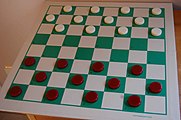
A checkerboard (American English) or chequerboard (British English; see spelling differences) is a game board of checkered pattern on which checkers (also known as English draughts) is played.[1] Most commonly, it consists of 64 squares (8×8) of alternating dark and light color, typically green and buff (official tournaments), black and red (consumer commercial), or black and white (printed diagrams). An 8×8 checkerboard is used to play many other games, including chess, whereby it is known as a chessboard. Other rectangular square-tiled boards are also often called checkerboards.
Games and puzzles using checkerboards
[edit]
Martin Gardner featured puzzles based on checkerboards in his November 1962 Mathematical Games column in Scientific American. A square checkerboard with an alternating pattern is used for games including:
- Amazons
- Chapayev
- Chess and some of its variants (see chessboard)
- Czech draughts
- Draughts, also known as checkers
- Fox games
- Frisian draughts
- Gounki
- International draughts
- Italian draughts
- Lines of Action
- Pool checkers
- Russian checkers
The following games require an 8×8 board and are sometimes played on a chessboard.
Mathematical description
[edit]Given a grid with rows and columns, a function ,
or, alternatively,
The element is black and represents the lower left corner of the board.
Gallery
[edit]-
An empty 8×8 checkerboard
-
An empty 8×8 checkerboard diagram
-
The opening setup of international draughts, which uses a 10×10 checkerboard
-
English draughts tournament standard
See also
[edit]References
[edit]- ^ Weisstein, Eric W. "Checkerboard". mathworld.wolfram.com.










Well, that’s interesting to know that Psilotum nudum are known as whisk ferns. Psilotum nudum is the commoner species of the two. While the P. flaccidum is a rare species and is found in the tropical islands. Both the species are usually epiphytic in habit and grow upon tree ferns. These species may also be terrestrial and grow in humus or in the crevices of the rocks.
View the detailed Guide of Psilotum nudum: Detailed Study Of Psilotum Nudum (Whisk Fern), Classification, Anatomy, Reproduction